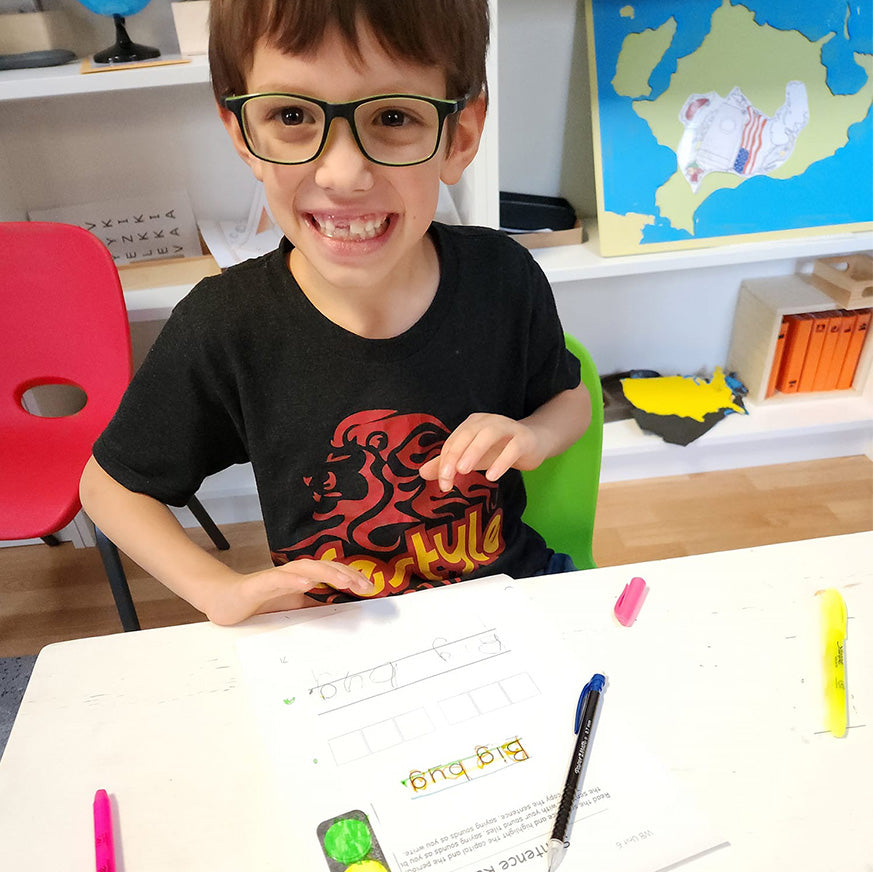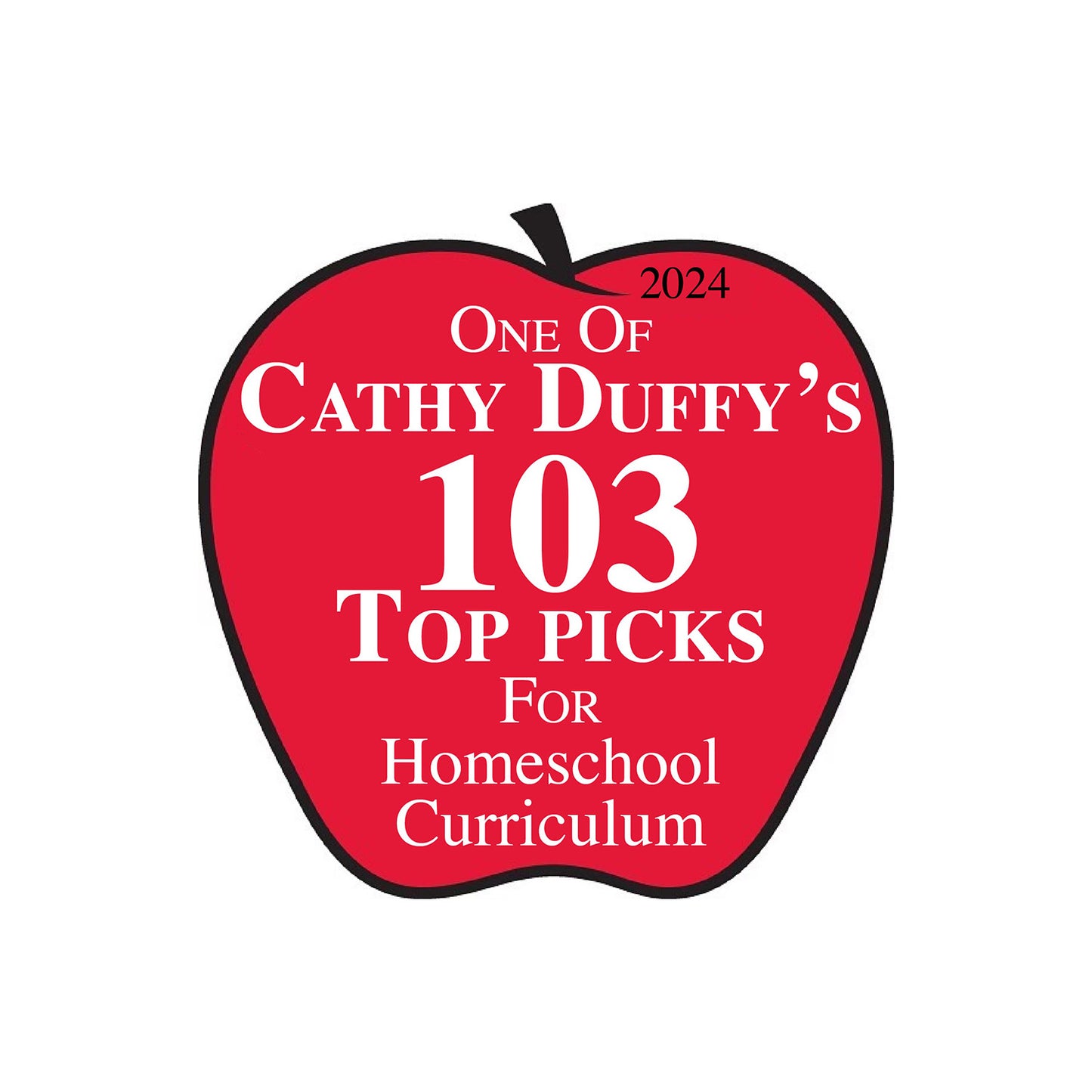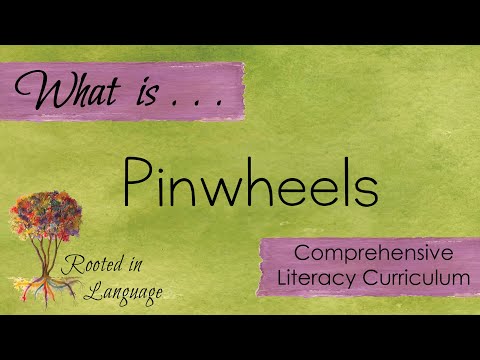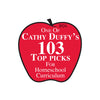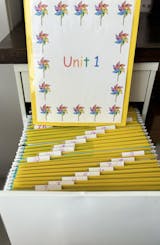What makes Pinwheels different?
- Pinwheels is based on research-supported strategies and approaches from the Science of Reading.
- Pinwheels supports all learners, including those who struggle with dyslexia, dysgraphia, and developmental language disorders — the three most common causes of literacy delays.
- Activities and practice are both multisensory and multimodal, meaning that they use more than one mode of language—listening, speaking, reading, or writing.
- Throughout Pinwheels, reading, writing, and spelling are taught together. Research supports teaching these in combination to ensure deep learning of new concepts.
- Explicit lessons in every area of language arts include educator scripts and student materials that are meaningful and fun.
- The practice of Intentional Copywork, Dictation & Editing is incorporated throughout, in a developmentally appropriate way.
- Review is strategically incorporated throughout to solidify key concepts in long-term memory.
- Student assessments are provided to help educators determine which concepts have been mastered vs. those that need more targeted practice. Assessments also measure growth over time.
- Professional development is included: as you teach, you will learn the why as well as the how, gaining universally usable strategies along with the know-how and confidence to apply them.
- Pinwheels is delivered through the online learning platform, Thinkific, for flexible engagement with materials and videos.
###
Where do I start with Pinwheels?
Start with Pinwheels Year 1 if your learner:
- is new to reading, writing, and spelling
- does not know the primary sounds of all letters
- cannot read and spell most simple 3-sound words
- does not know most short vowel sounds
Start with Pinwheels Year 2 if your learner:
- can read and write most letters and say their primary sounds
- can read and spell simple words with short vowel sounds
- does not write and spell words with blends or multiple syllables
- cannot spell with basic vowel teams and Silent-e
Note: Pinwheels Year 2 begins with two units that review key concepts from Pinwheels Year 1. If you are new to Pinwheels, starting with Year 2, take extra time with these first two units. If any concepts are new or challenging for your student, provide extra practice. If more explicit teaching is needed on these concepts, that is provided in Pinwheels Year 1.
###
How long will it take to complete Pinwheels Year 1 or Year 2?
Each Pinwheels product is designed to be completed in approximately one school year. However, actual completion time is dependent upon many factors, including your instructional hours per week, as well as each student’s learning pace and need for modifications.
###
Who should use Pinwheels?
Pinwheels Year 1 is designed for the average 5-6 year old. However, Pinwheels targets a skill level rather than an age. This means that older students who need support in the acquisition of early literacy skills, alphabet knowledge, and letter formation should use Pinwheels.
Pinwheels Year 2 is designed for the average 6-8 year old. However, Pinwheels targets a skill level rather than an age. This means that older students who need support as they begin to consolidate early reading, writing, and spelling knowledge should use Pinwheels.
###
Can Pinwheels be used to teach an older student?
Yes. Pinwheels is designed to support students who have dyslexia, dysgraphia, and/or developmental language disorders — the three most common causes of literacy delays. Learners with these language-based struggles have unexpected gaps in their literacy knowledge that impede progress. Because Pinwheels is so thorough in its approach and develops foundational writing skills, both educators and older students benefit from working with this program.
Note: Some of the content may be a review, but the explicit lessons strengthen foundational skills. Supplemental reading material may be needed.
Because Pinwheels Year 1 focuses on building a solid sound-to-letter foundation, it is appropriate for older these students. Older students with dysgraphia benefit from Year 1’s slower writing pace, sound-to-letter practice, and reduced writing demands.
###
Can Pinwheels be used to teach a 4-5 year old who is already reading CVC words?
Yes. Pinwheels Year 1 is still a good place to start. Remember that Pinwheels teaches not just reading, but also writing, letter formation, spelling, punctuation, capitalization, word study, CVCC words, early suffixing, simple grammar concepts, and more. Some young Pre-K students may already read CVC words, but they usually need more practice writing and spelling at this grade level. Familiar material can be reviewed at a faster pace, but all the while, your student will build a solid literacy foundation: learning and using important strategies for accurate reading and fluent writing. In addition, younger children learn early editing skills presented in a kind and age-appropriate manner. The teaching strategies in Pinwheels are key ingredients to future success in spelling and fluent writing!
You may have to add additional reading opportunities to match your child’s reading level, so we provide a list of other readers that can be used with the program.
Here is some helpful advice from our Rooted Community Pinwheels users with young learners:
- “I’ve found with my kiddo when we have material she’s already familiar with, her confidence grows and she’s more open to the challenging aspects. We just finished Level 1 today and my kiddo is grasping suffixes, blending, CVCC, early grammar concepts, and more.” ~ Samantha
- “My daughter was already reading at 4.5 when we started Pinwheels. We started at Level 1 and it was perfect. We skipped a lot of the extra practice ideas, the easiest worksheets (missing sounds 1-3), etc. but we did the majority of it. It was the correct amount of writing, and she developed amazing spelling skills to match her natural reading abilities.” ~ Ashley
- “I did it with a kid who could read well, maybe 5th grade level self taught, but we needed handwriting, spelling, grammar, etc. She loved it! We definitely modified and went through it fast (a couple months). But there was so much to learn!” ~ Elisa
- “It's a full language arts program so they learn other things as well. We recently finished Level 1. There's a lot of practice with capitalizing the beginning of a sentence, punctuation marks, editing, saying sounds as you write, phonemic awareness, reading, and writing fluency. You just may be able to go at a faster pace. There's actually way more of the other stuff. You'll probably be adding in other reading opportunities.” ~ Maryellen
###
Can Pinwheels be used to teach students with language delays?
Yes. Pinwheels is designed to support students who have dyslexia, dysgraphia, and/or developmental language disorders — the three most common causes of literacy delays.
Learners who struggle will experience a slower learning pace and increased cognitive fatigue, resulting in reduced attention. In addition, writing tasks pose a particular challenge. Pinwheels is designed with therapeutic, short lessons which easily modify the daily pace. Hands-on manipulatives, games, and extra practice activities are abundant . . . essential tools for the struggling learner. Extra practice is built in the program, and educator guidance is provided.
###
What if my student needs a quicker pace?
Pinwheels Year 1 provides numerous engaging practice opportunities. If your student is advancing rapidly with strong sound-to-letter connections and needs a quicker pace, an accelerated plan is provided which includes reducing familiar practice and focusing on the more challenging activities. Many students will progress more rapidly in their reading skills than in their writing skills, yet writing is the deepest form of learning. Always include writing practice activities so students have additional time for writing skills to progress.
Pinwheels Year 2 covers many areas of language arts. If your student is advancing rapidly with reading, writing, and spelling, recommendations are provided to elevate the challenge level which include reducing familiar practice, focusing on the more challenging activities, and increasing the writing demands. Be sure to do some practice for every new concept before moving on. Many students will progress more rapidly in their reading skills than in their writing skills. If so, provide supplemental reading material, but also have advanced readers engage in Pinwheels’ multisyllable reading practice. Always include Pinwheels writing practice because writing requires the application of all other literacy skills. Allow the time your student needs for original writing, editing, and spelling skills to progress.
###
What supplies do I need to teach with Pinwheels?
- A detailed Materials List is provided in the Pinwheels Plan & Prep PDF and in the Setup modules on Thinkific.
- Most of the supplies needed are typical office and school supplies. Some craft supplies are also needed.
- Paper: The Print & Setup module on Thinkific provides guidance for each document; 24lb. paper is recommended for double-sided printing; cardstock is recommended for some Appendix materials
- Lamination is not required, although we note when lamination may be beneficial for specific materials.
- Documents can be stored in 3-ring binders or in folders by unit, depending on user preference.
- Student binders are recommended for specific purposes; details are provided on the Materials list.
###
Do you have an alternative to printing and cutting all those Letter Tiles?
Yes. Treasures from Jennifer has created two wooden Rooted in Language Letter Tile sets — coins and square tiles.
The RiL Letter Tile set represents all the tiles for the complete code, including spellings that are beyond the scope of Pinwheels. The student’s working set of Letter Tiles should only include the sounds and spellings that have been explicitly taught. It will grow over time. Store the remaining Letter Tiles separately, for future use.
###
What are my printing options? Who are your print partners and how much does it cost to print through them?
- Print and setup recommendations are provided in the Pinwheels Print & Setup module on Thinkific.
- We offer coil bound print-on-demand books for some Pinwheels student materials.
- Pinwheels can be printed at home, through one of our print Partners, or through a printing company of your choice. Some local libraries offer free or discounted printing.
- Some print Partners provide discounts for RiL customers. Please contact the print company to inquire about their pricing. RiL does not receive remuneration from any print company nor control their print prices.
###
Do I have to print everything?
- Printing is optional for the educator materials (40% optional for Year 1; 53% optional for Year 2). You decide which educator elements to print versus what you wish to read and reference on your screen.
- Student materials should be printed, including: Student Workbooks, Reading Kits, and Appendix materials.
- See the Viewing and Printing section above for more printing information.
- After purchase, refer to the Pinwheels Print & Setup module on Thinkific.
###
How many pages are in each Pinwheels resource?
See the Materials section above for all the details.
###
For the home educator: How can I purchase Pinwheels using my charter school funds?
- Charter schools can contact us to issue a purchase order to Rooted in Language. The purchase order must include the home educator’s email address for delivery of the digital product.
- Charter schools can purchase Pinwheels on your behalf through our online Shop. The family's email address and parent name must be entered at checkout for delivery of the product; then the charter school proceeds to PayPal for payment where the school's email address is entered for a PayPal receipt. Download these instructions for charter school website orders.
- If Rooted in Language is not already an approved vendor with your charter school, contact us so we can complete your charter’s vendor application.
###
For the home educator and co-op educator: Can I teach with Pinwheels in a co-op?
- Pinwheels is licensed for home educators and private tutors to use the program with their own children, children for whom they have legal guardianship, and one-on-one, private tutoring students in a private practice setting only.
- If you would like to pursue teaching with Pinwheels in a co-op, special licensing may be required. Contact us for co-op licensing options before purchasing Pinwheels. A co-op is defined as a learning environment where several homeschool families join together for academic pursuits, and parents work cooperatively in teaching different subjects in a group setting.
- We believe students gain the most skill when they use Pinwheels in its entirety. Therefore, we strongly recommend each co-op student’s family purchase the curriculum for weekly assignments to complete at home. This also supports students who struggle and will need extra practice at home.
###
For the school, classroom teacher, and school tutor and interventionist: Do you offer a license to use Pinwheels in a classroom or school?
Yes. Please see our Pinwheels School License for all the details about licensing Pinwheels for a single, physical school location.












